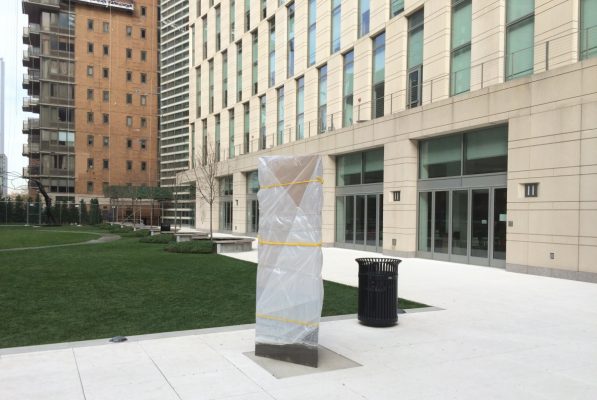Robert Moses Plinth To Be Altered
September 29, 2016
A plaque or engraving will be added to the Robert Moses plinth on campus.
The decision to alter the monument follows the United Student Government (USG) recommendation in April to keep the plinth. USG also pushed for a plaque giving context as to who Robert Moses was and the impact the construction of the Lincoln Center campus had on the communities in the area.
USG’s plan is to form a plinth engraving committee to decide what will be included in the engraving or on the plaque, according to Leighton Magoon, Fordham College at Lincoln Center (FCLC) ’17 and USG president.
Vice President for Lincoln Center Brian Byrne, Ph.D., confirmed that such an effort was underway, but could not say what the perspective of the final plaque or engraving would be.
“Ideally what we would want to do is in a concise manner, emphasize and give some sort of recognition to the communities that were impacted by Robert Moses’s urban planning, like the communities that were displaced in this area that originally had this land before Fordham was here,” Magoon said. “So with the attention of ‘this is where we come from.’ We want to remember those who lost what they had and were pushed out for this opportunity that we have.”
Magoon noted that USG will be reaching out to the Dorothy Day Center for Social Justice, the Office of Multicultural Affairs, the Urban Studies Department as well as other departments on campus “to try and get some thoughts on how we can sort of put that concisely and appropriately so that it’s in remembrance to those communities in a respectful way.”
“He was an individual who created a great deal of change, but there were also a lot of side effects, some of them not particularly beneficial,” said Roger Panetta, visiting professor of history who took part in a panel discussion on Robert Moses’s legacy in April. He mentioned the gentrification and the displacement of communities that occurred as a result of Moses’s urban planning.
“And the question became what are you going to look at,” Panetta said regarding the event. “Are you going to look at the people displaced? Or are you going to look at something like Lincoln Center as a physical legacy of his work? And I think the consensus in the room after a while was they’re both there. That is, he deeply transformed New York City, but there was a staggering amount of displacement.”
“We tried to find a way to embrace both of those views,” he continued. “Moses the builder and Moses the disrupter. And he uses power to create and abuses it at times to move people.”
Panetta pointed to other universities that have had discussions over their controversial histories, such as Georgetown University discussing slavery and Princeton University discussing Woodrow Wilson’s racism.
“At Princeton, Woodrow Wilson’s portrait was removed from the dining commons, because there was this racist history,” Panetta said. “But what happens now that you remove that? You obliterate his history as the president of the university, that he was there and that he was an influence. And so some people say take it down and that’s the end of it. He doesn’t deserve to be honored.”
“And what I think I like about the Fordham decision so much is that it acknowledges the ambiguity of things,” he continued. “It doesn’t sanitize. It doesn’t eradicate. It says we have to live with these ambiguities. This guy did some good things, and he did some not so good things. And the way to deal with that in my opinion is to face both of those and for us to deal with the contradictions.”
Panetta added that he wants to commend the University on their decision “because I thought that was the right way to do it,” he said.
“Because not to act precipitously, to have an open discussion, to encourage students to participate and take part in that discussion, I was very pleased to be a part of that, but I thought it was a smart way to deal with it,” he said.
Magoon added that any member of the Fordham community who wishes to voice their opinion or sentiment on what should be included in the engraving or on the plaque should email [email protected]. “We think it’s important to acknowledge that we wouldn’t be here without Robert Moses,” he said. “but we also can do that while acknowledging the human impact of what Robert Moses did for us to be here.”










